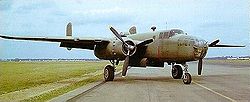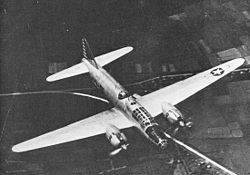- Medium bomber
-
 The B-25B Mitchell, a medium bomber.
The B-25B Mitchell, a medium bomber.
 The Japanese Mitsubishi G4M "Betty", a medium bomber (captured and tested by U.S. forces).
The Japanese Mitsubishi G4M "Betty", a medium bomber (captured and tested by U.S. forces).
A medium bomber is a bomber aircraft designed to operate with medium bombloads over medium distances; the name serves to distinguish them from the larger heavy bombers and smaller light bombers. The term was used prior to and during World War II, when engine power was so meager that designs had to be carefully tailored to their missions[citation needed].
The medium bomber was generally considered to be any level bomber design that delivered about 4,000 pounds (1,800 kg) of ordnance over ranges of about 1,500 to 2,000 mi (2,400 to 3,200 km). Heavy bombers were those with a nominal load of 8,000 pounds (3,600 kg) or more[citation needed], and light bombers carried 2,000lb (907kg)[citation needed]. These distinctions were beginning to disappear by the middle of World War II, when the average fighter aircraft could now carry a 2,000 lb (907 kg) load and ever more powerful engines allowed "light" bomber designs (and later jet fighter bombers) to largely take over the missions formerly filled by mediums.
After the war the term disappeared from use almost instantly; some of this was due to mass demobilization of the participant air forces' existing equipment, and the fact that several of the most-produced medium bomber types were now technologically obsolescent. Although a number of later aircraft were designed in this performance and load-carrying range, they were henceforth referred to as tactical bombers instead. Examples of post-war mediums include the English Electric Canberra (along with its derived U.S. counterpart, the Martin B-57) and the Soviet Ilyushin Il-28 "Beagle".
Examples
- Introduced prior to WWII
- Armstrong Whitworth Whitley - first of three British medium bombers
- Bloch MB.210
- CANT Z.1007
- Dornier Do 23
- Fiat BR.20 - first all-metal Italian bomber
- Handley Page Hampden - British medium bomber, almost as fast as the Bristol Blenheim
- Heinkel He 111 - considered a heavy bomber by the Luftwaffe for some missions
- Ilyushin DB-3 - precursor to the Il-4 (see below)
- Junkers Ju 86
- Lioré et Olivier LeO 45 - fast French medium bomber
- Mitsubishi G3M - known to the Allies as "Nell"
- Mitsubishi Ki-21 - "Sally"; replaced some Fiat BR.20 bombers in Imperial Japanese Army Air Force service
- PZL.37 Łoś
- Savoia-Marchetti SM.79
- Vickers Wellington - most-produced medium bomber, capable of a range of 2,500 miles
- World War II
- Dornier Do 217 - considered a heavy bomber by the Luftwaffe for some missions
- Ilyushin Il-4 - long ranged Soviet bomber
- Junkers Ju 88
- Martin B-26 Marauder
- Mitsubishi G4M - known to the Allies as "Betty"
- Mitsubishi Ki-67 Hiryū - Allied reporting name "Peggy"; classified as heavy by Imperial Japanese Army Air Force
- Nakajima Ki-49 Donryu - "Helen"
- North American B-25 Mitchell
- Tupolev Tu-2
- Yermolayev Yer-2
- Yokosuka P1Y Ginga - a medium bomber to the Imperial Japanese Navy Air Service; but in size, weight, speed etc. similar to Allied light bombers such as the Douglas A-26 Invader
- Post war
- English Electric Canberra
- Ilyushin Il-28 - Soviet jet bomber
- Martin B-57 Canberra - U.S. development of the Canberra
- Convair B-58 Hustler - U.S. supersonic jet bomber
See also
Notes and references
Lists relating to aviation General Aircraft (manufacturers) · Aircraft engines (manufacturers) · Airlines (defunct) · Airports · Civil authorities · Museums · Registration prefixes · Rotorcraft (manufacturers) · TimelineMilitary Accidents/incidents Records Categories:- Bomber aircraft
Wikimedia Foundation. 2010.

